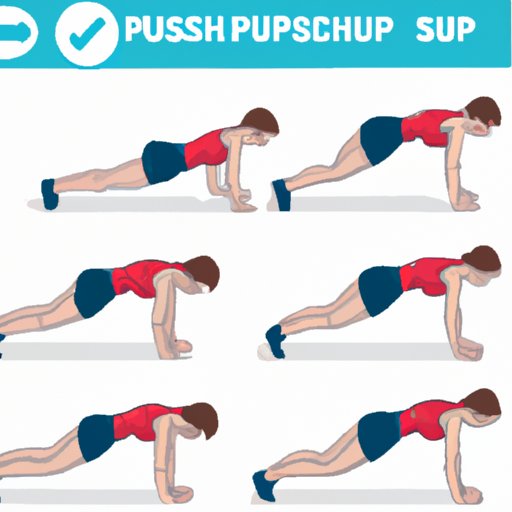Introduction
Are you looking to improve your upper body strength? Look no further than the humble push-up! Push-ups are one of the most effective exercises for building chest, triceps, and shoulder strength. In this article, we’ll cover everything you need to know to master this classic exercise.
The Proper Push-Up Mechanics
Before we dive into variations and modifications, it’s important to first master the basic form of a push-up. Proper form not only ensures that you’re targeting the right muscles, but it also helps prevent injury.
Step-by-step guide to performing a push-up
1. Start on all fours with your hands slightly wider than shoulder-width apart.
2. Extend your legs behind you so that your body forms a straight line from head to heels.
3. Keep your core engaged and lower your body until your chest touches the floor.
4. Push your body back up to the starting position.
5. Repeat for desired reps.
Common mistakes to avoid during push-ups
Some of the most common mistakes people make during push-ups include:
- Flaring your elbows out to the sides
- Dipping your chin or letting your head drop
- Letting your hips sag or arching your back
Tips for improving form and avoiding injury
When performing push-ups, it’s important to:
- Keep your elbows tucked in towards your torso
- Keep your gaze forward and your neck in a neutral position
- Keep your core engaged to prevent your hips from sagging or your back from arching
- Lower yourself only as far as you can while maintaining proper form
How to Increase Your Push-Up Reps
Once you’ve mastered proper form, the next step is to build strength and endurance to increase your push-up reps. Here’s how to do it:
Beginner’s guide to building strength and endurance
If you’re new to push-ups, start by doing 2-3 sets of 5-10 reps with proper form and taking breaks as needed. As you get stronger, gradually increase your reps and number of sets.
Tips and tricks for increasing push-up reps
Other tips for building push-up strength and endurance include:
- Doing push-ups more frequently throughout the day
- Incorporating other upper body exercises to target the same muscles
- Using resistance bands or weights to increase difficulty
Importance of rest and recovery for strength gains
Remember, it’s important to give your muscles time to rest and recover between workouts. Consider taking a day off in between push-up sessions to allow your muscles time to recover.
Push-up Variations
If you’re looking to spice up your push-up routine, there are plenty of variations to choose from. Not only do variations target different muscles, but they also add variety to your workout.
Advanced push-up variations to target different muscle groups
Some popular push-up variations include:
- Diamond push-ups (targets triceps)
- Wide-grip push-ups (targets chest)
- Decline push-ups (targets shoulders)
How to incorporate push-up variations into a workout routine
To incorporate push-up variations into your routine, try doing a different variation each day. For example, on Monday, do regular push-ups. On Tuesday, do diamond push-ups. And so on.
Correcting Common Push-up Mistakes
Even if you’re a push-up pro, it’s still possible to make mistakes. Here are some common mistakes to watch out for:
Explanation of why these mistakes are detrimental to progress
Mistakes such as flaring your elbows out or letting your hips sag can not only lead to poor form, but they can also put you at risk for injury.
Tips and tricks for fixing common mistakes
If you’re struggling with push-up form, focus on slowing down and really engaging your muscles. Consider doing easier modifications until you’ve built up enough strength to do full push-ups with proper form.
Push-up Modifications for Beginners
Push-ups can be intimidating, especially if you’re a beginner. But there are plenty of modifications you can make to make push-ups more accessible.
List of modifications for beginners
Some modifications to try include:
- Doing push-ups from your knees instead of your toes
- Using a bench or step to do inclined push-ups
- Doing wall push-ups
How to incorporate modifications into a workout routine
Like with push-up variations, incorporate modifications by doing a different modification each day. For example, on Monday, do wall push-ups. On Tuesday, do inclined push-ups.
Benefits of Doing Push-ups
Push-ups come with a ton of benefits beyond just building upper body strength.
List of health benefits associated with doing push-ups
Some health benefits of push-ups include:
- Improved posture
- Increase in bone density
- Improved cardiovascular health
- Improved balance and stability
How push-ups can improve fitness goals
Push-ups can help you reach a variety of fitness goals, whether you’re trying to tone your upper body or increase overall strength and endurance.
Conclusion
Push-ups are one of the most effective exercises for building upper body strength, but they’re also versatile enough to fit any fitness level. Whether you’re a beginner or a pro, there’s always room for improvement when it comes to performing the perfect push-up. Remember to prioritize proper form, rest and recovery, and incorporating variations and modifications to keep your workout fresh.
